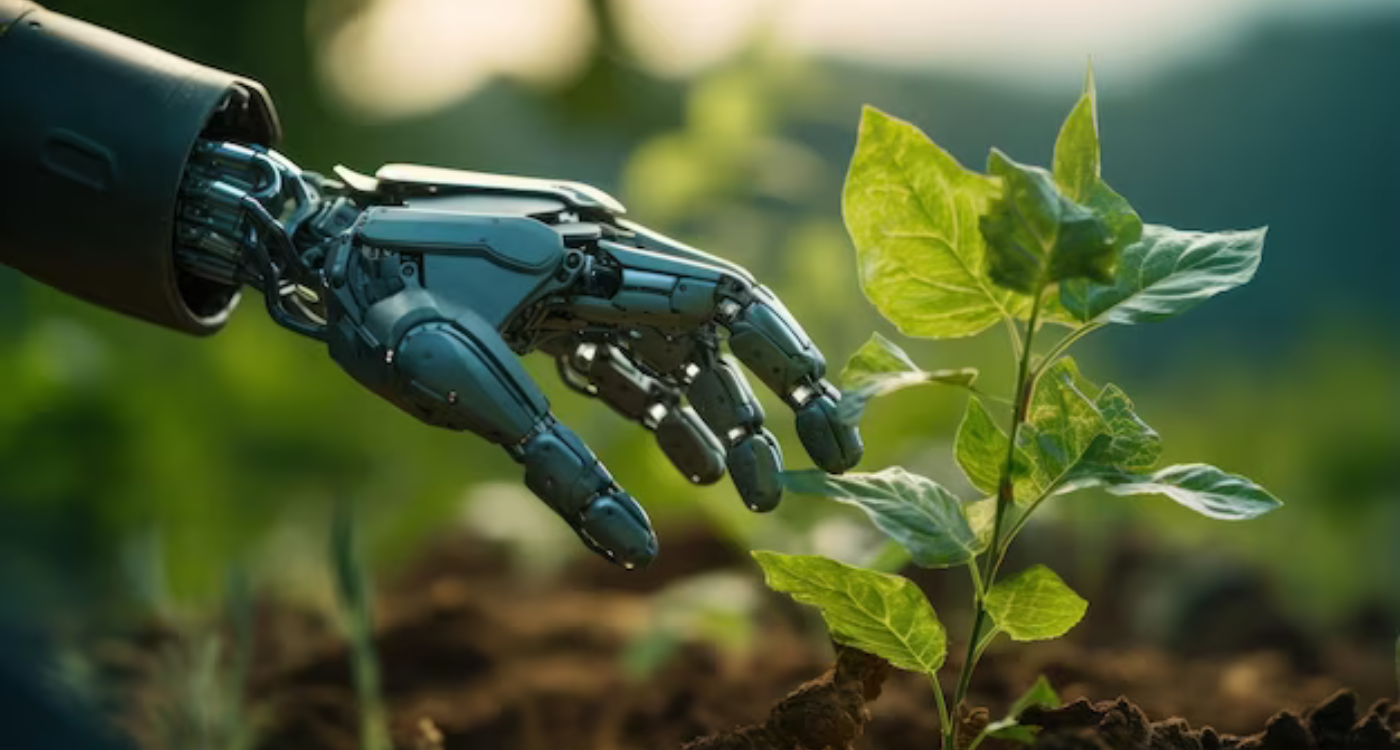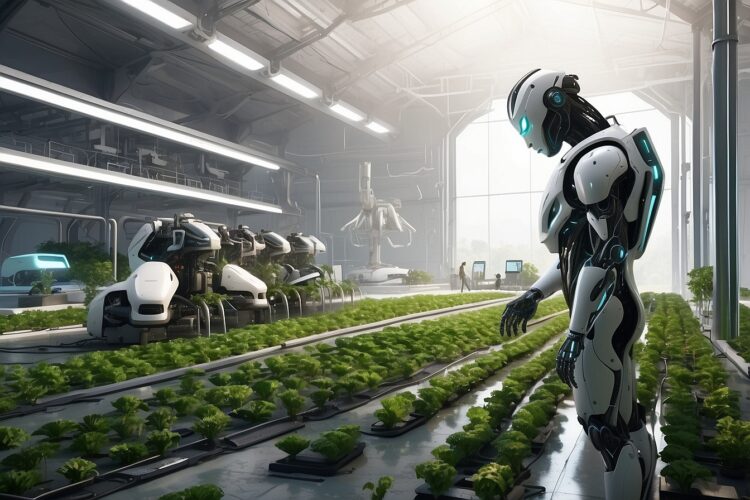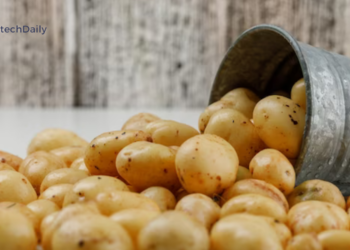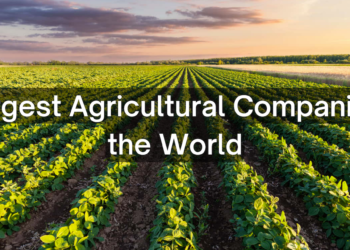Harvesting the Future: Unleashing the Potential of AI and Robots in Agriculture
Introduction
Defining the Marvel of Robotics in Agriculture
Imagine a world where crops are tended to with unprecedented precision, where the soil is nourished with exactitude, and where harvesting becomes an automated symphony. This is the realm of robotics in agriculture, a groundbreaking and rapidly evolving field that blends advanced artificial intelligence (AI) with cutting-edge robotics technology to revolutionize farm labor. In simple terms, robotics in agriculture refers to the utilization of autonomous machines and AI-driven systems to perform various tasks on farms that were traditionally carried out by human laborers.
A Glimpse into History: The Evolution of Robotics in Agriculture
The integration of robots into farming practices might seem like a recent development, but its roots can be traced back several decades. The early pioneers of agricultural robotics envisioned a future where machines would alleviate the burden on farmers and enhance productivity. As early as the 1960s, researchers began exploring robotic solutions for planting seeds and harvesting crops.
However, it was not until advancements in technology caught up with their dreams that these ideas started turning into reality. Over time, robotics in agriculture has witnessed remarkable progress due to leaps and bounds made in AI algorithms, sensor technology, and data analysis techniques.
Today’s intelligent robots possess an unparalleled ability to perceive their environment, make autonomous decisions based on real-time data, and execute tasks efficiently. From humble beginnings to this futuristic panorama, the history of robotics in agriculture serves as a testament to human innovation and our quest for an enhanced farming experience.

The Crucial Significance: Why AI and Robots are Transforming Farm Labor
The integration of AI-powered robots into farm labor brings forth numerous benefits that are increasingly crucial for modern-day agriculture. One such advantage lies in increased efficiency; these smart machines automate repetitive tasks with precision while minimizing errors caused by human fatigue or distractions. Imagine a tireless robotic hand that can sow seeds, water plants, and tend to crops all day and night without rest.
Moreover, AI and robots offer significant cost savings for farmers. By reducing the need for manual labor, these automated systems alleviate the financial burden associated with employing large farm workforces.
Additionally, they optimize resource utilization by precisely managing water usage and fertilizers, thereby minimizing waste and maximizing crop yield. In this era of global climate change concerns, the environmental sustainability aspect of robotics in agriculture cannot be ignored.
The precise application of fertilizers and pesticides through AI-driven machines minimizes their potential negative impact on surrounding ecosystems. Furthermore, smart irrigation systems monitor soil moisture levels with exactitude to ensure optimal use of water resources.
Thus, AI-powered robots not only revolutionize farm labor but also contribute to a greener and more sustainable future. Stay tuned for the next sections, where we delve deeper into the bounty of benefits brought by robotics in agriculture and explore fascinating applications across different aspects of farm labor!
The Benefits of Robotics in Agriculture
Increased efficiency and productivity on farms
Robots in agriculture have revolutionized the farming industry by significantly enhancing efficiency and productivity. One of the key advantages is the automation of repetitive tasks. Traditionally, farmers had to manually perform monotonous activities such as planting seeds, weeding, and harvesting.
This required immense time and effort, often resulting in exhaustion and decreased effectiveness. With robots taking over these repetitive tasks, farmers can focus on more strategic aspects of their operations.
Furthermore, robots offer a reduction in human error. Even skilled workers can make mistakes due to fatigue or distractions, leading to inconsistencies in farm management.
However, robots operate with precision and accuracy, following predetermined algorithms to carry out tasks flawlessly. By minimizing errors during processes like planting or applying pesticides, farmers experience improved crop yield and quality.

Cost savings for farmers
The integration of robotics into agriculture also brings significant cost savings for farmers. Firstly, replacing human labor with robots leads to decreased labor costs.
Hiring and managing a large workforce can be expensive for farmers, especially during peak seasons when demand for labor is high. By employing robots instead of humans for repetitive tasks like seeding or harvesting crops, farmers can reduce their dependency on manual labor and save substantial amounts of money.
Moreover, robotics enables optimal resource utilization on farms. For instance, through precise application systems integrated into robotic technology, fertilizers and pesticides can be accurately administered only where needed.
This prevents excessive use that not only wastes resources but also poses environmental risks such as water pollution or soil degradation. Additionally, smart irrigation systems driven by robotic technology contribute to environmental sustainability by conserving water resources.
These systems utilize sensors that monitor soil moisture levels in real-time and adjust irrigation accordingly. As a result, water usage is optimized based on the specific needs of crops at any given time.
By embracing robotics in agriculture, farmers can experience a range of benefits, including increased efficiency and productivity, cost savings, and environmental sustainability. As technology continues to advance, these advantages are only expected to grow further, making farming operations more streamlined and sustainable than ever before.
Crop Monitoring and Management
Rising Above: Drones for Aerial Surveillance
Gone are the days of farmers tirelessly walking their vast fields to monitor crop health and growth patterns. Thanks to the advent of robotics in agriculture, drones now take flight as vigilant farm assistants.
Equipped with high-resolution cameras and advanced sensors, these aerial wonders sweep across the fields, capturing detailed images and collecting data that would otherwise be a laborious task. The captured images provide valuable insights into crop conditions, allowing farmers to make informed decisions on irrigation, pest control, and fertilizer application.
Moreover, drones have become indispensable in identifying potential issues such as nutrient deficiencies or disease outbreaks. By analyzing multispectral imagery captured by drones, AI algorithms can detect subtle changes in plant foliage that are undetectable to the human eye.
This enables early intervention measures to be taken before problems escalate further. With this powerful combination of AI-driven analysis and drone technology, farmers can revolutionize their crop management practices while maximizing yields and minimizing environmental impact.
Weed Warriors: Automated Detection and Removal
Weeds are the nemesis of every farmer’s existence. Traditionally fought through arduous manual labor or chemical herbicides, weeds have met their match in the realm of robotics. With advancements in computer vision and machine learning algorithms, robots can now swiftly identify invasive plants among cultivated crops with remarkable accuracy.
Equipped with sophisticated imaging systems capable of differentiating between crops and unwanted plants based on shape, color, and texture analysis, these robotic warriors selectively target weeds without harming surrounding vegetation. Once detected, state-of-the-art mechanical arms equipped with cutting-edge tools meticulously remove intruders from the soil bed.
By leveraging AI-powered weed detection technologies coupled with robotic precision for removal purposes, farming practices undergo a remarkable transformation. Weed control becomes more efficient than ever before while minimizing chemical dependence that may harm ecosystems and contaminate harvests.

Challenges Faced by Robotics in Agriculture:
Technical Limitations: Adapting to Diverse Farm Environments
The implementation of robotics in agriculture encounters several technical limitations, one of which is the ability to adapt to diverse farm environments. Farms come in various shapes and sizes, each with its unique set of challenges. Some farms have intricate landscapes, uneven terrains, or narrow pathways that pose difficulties for traditional robots.
For instance, a robot designed for large-scale industrial farming may struggle to navigate through small organic farms with tight spaces between crops. To address this challenge, engineers are developing robots equipped with advanced sensors and algorithms that enable them to detect and maneuver around obstacles effectively.
These robots utilize cutting-edge perception technologies like computer vision and lidar systems to create detailed maps of their surroundings. By analyzing these maps in real-time, they can make accurate decisions on the best routes to take while avoiding potential collisions or damage to crops.
Another aspect of adapting to diverse farm environments is the capacity to handle varying weather conditions. Farms experience different climates throughout the year, which can be harsh at times.
Robots need robust designs that can withstand extreme temperatures, high humidity levels, or heavy rainfalls without compromising their performance. Furthermore, they must be capable of operating both indoors and outdoors seamlessly.
Technical Limitations: Handling Delicate Crops Without Damage
One key challenge faced by robotics in agriculture revolves around handling delicate crops without causing damage during harvesting or other agricultural activities. Certain crops require gentle handling due to their fragility or susceptibility to bruising or crushing when subjected to excessive force.
Developing robotic systems capable of delicately manipulating fruits like strawberries or grapes requires precision control mechanisms coupled with soft grippers that mimic human touch sensitivity. Engineers are exploring novel materials and designs that minimize impact forces during grasping and transport operations while ensuring a secure grip on the produce.
By integrating force sensors and tactile feedback mechanisms into robotic hands, these systems can adjust their grip strength and pressure to avoid causing harm. Additionally, the ability to differentiate between ripe and unripe crops presents a significant challenge.
Humans possess the knowledge and experience to visually identify when a fruit or vegetable is ready for harvest, but replicating this expertise in robots requires sophisticated algorithms capable of analyzing color, texture, size, and other relevant factors. Researchers are working on developing AI-powered vision systems that can accurately assess the ripeness of crops and thus optimize harvesting operations.
Social Acceptance: Impact on Rural Employment
As robotics in agriculture advances, concerns about its impact on rural employment arise. Automating certain tasks that were previously performed by human labor raises questions about job displacement and its consequences for rural communities heavily reliant on agricultural work. While it is true that robots can replace manual labor, it is important to note that they also create new job opportunities.
The development, maintenance, programming, and monitoring of robotic systems require skilled technicians and engineers who can contribute to the growing field of agricultural robotics. Moreover, as robots take over repetitive or physically demanding tasks like weed removal or fruit picking, human workers can shift their focus towards more skilled roles such as overseeing operations or data analysis.
To ensure a smooth transition in the workforce dynamics caused by robotics in agriculture, policymakers must invest in retraining programs for agricultural workers. These programs should equip farmers with the necessary skills to operate and maintain robotic systems effectively.
Education institutions can play a crucial role by incorporating courses related to automation technologies in their curricula. While there are challenges associated with implementing robotics in agriculture—such as technical limitations related to adapting to diverse farm environments and handling delicate crops without damage—the potential benefits outweigh these obstacles.
Furthermore, addressing social acceptance issues through skill-building initiatives will help mitigate concerns about employment displacement within rural communities. By embracing technological advancements responsibly while considering the needs of farmers and the environment, we can pave the way for a more efficient and sustainable future in agriculture.
Future Trends in Robotics for Agriculture
Advancements in Machine Learning Algorithms: Cultivating Smarter Farms
As technology continues to evolve, so does the potential for advancements in machine learning algorithms that can revolutionize the field of agriculture. With the help of artificial intelligence (AI), robots are becoming increasingly intelligent and capable of making autonomous decisions based on real-time data analysis. These advancements enable them to adapt and respond to changing environmental conditions, ultimately contributing to smarter and more efficient farming practices.
Machine learning algorithms allow robots to learn from large amounts of data collected from various sources, such as weather patterns, soil composition, and crop growth rates. By analyzing this data, robots can make informed decisions about irrigation schedules, optimal fertilizer application rates, and even predict disease outbreaks.
This level of precision not only maximizes crop yield but also minimizes resource waste by applying inputs only where they are needed. With further advancements in machine learning algorithms, we can expect even greater insights into agricultural processes that will lead to reduced costs and improved sustainability.
Real-Time Decision Making Based on Data Analysis: The Power of Immediate Insight
One of the most exciting future trends in robotics for agriculture is the ability for robots to engage in real-time decision-making based on data analysis. Through constant monitoring and analysis of various parameters, such as soil moisture levels, nutrient content, and weather conditions, robots can make immediate adjustments to farming operations. This dynamic approach allows farmers to address issues promptly and mitigate risks before they escalate.
Real-time decision-making has far-reaching implications for crop management. For instance, if a robot detects a sudden drop in soil moisture levels due to unexpected heat waves or prolonged drought conditions, it can trigger an automated irrigation system immediately.
Similarly, if pests or diseases are detected early through sophisticated sensors on robotic platforms or drones hovering over fields with high-resolution cameras, targeted interventions can be swiftly implemented. The speed and accuracy of real-time decision-making significantly reduce crop losses and ensure optimal plant health, ultimately enhancing the overall efficiency and sustainability of agricultural practices.
Conclusion
As technology continues to advance, the role of AI and robots in agriculture becomes increasingly prominent. The future trends in robotics for agriculture discussed here hold immense potential for transforming farming practices as we know them.
Advancements in machine learning algorithms will empower robots to make intelligent decisions based on vast amounts of data, fostering precision farming techniques that optimize resource utilization and enhance productivity. Additionally, real-time decision-making based on data analysis will enable farmers to respond swiftly to changing conditions and proactively manage risks.
This not only reduces losses but also enhances sustainability by minimizing the use of inputs such as water, fertilizers, and pesticides. With these advancements, the future of agriculture looks promising – a future where AI-powered robots work hand-in-hand with farmers to cultivate bountiful harvests while preserving our precious resources.
By embracing these technological developments, we can usher in an era where farming becomes more efficient, productive, and sustainable than ever before. So let us embrace the potential offered by robotics in agriculture and pave the way for a greener tomorrow filled with thriving farms nourishing both people and the planet alike!











